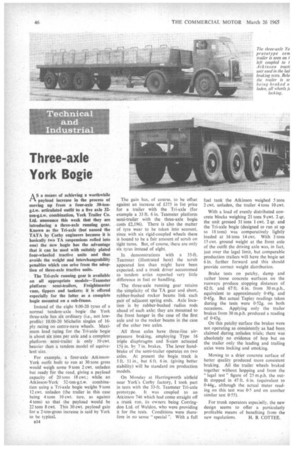Three-axle York Bogie
Page 48

If you've noticed an error in this article please click here to report it so we can fix it.
AS a means of achieving a worthwhile payload increase in the process of moving up from a four-axle 30-tong.t.w. articulated outfit to a five axle 32ton-g.l.w. combination, York Trailer Co. Ltd. announce this week that they are introducing a three-axle running gear. Known as the Trimaxle (but named the TATA by Corby engineers because it is basically two TA suspensions rolled into one) the new bogie has the advantage that it can be used with suitably plated four-wheeled tractive units and thus avoids the weight and interchangeability penalties which can arise from the adoption of three-axle tractive units.
The Tr-axle running gear is available on all appropriate models—Teamster platform semi-trailers, Freightmaster vans, tippers and tankers; it is offered especially for the latter as a complete bogie mounted on a sub-frame.
Instead of the eight 9.00-20 tyres of a normal tandem-axle bogie the York three-axle has six ordinary (i.e., not lowprofile) 10.00-20 Michelin singles of 16ply rating on centre-nave wheels. Maximum load rating for the Tr-axle bogie is about six tons per axle and a complete platform semi-trailer is only 10 cwt. heavier than a tandem model of equivalent size.
For example. a four-axle AtkinsonYork outfit built to run at 30 tons gross would weigh some 9 tons 2 cwt. unladen hut ready for the road, giving a payload capacity of 20 tons 18 cwt.; while an Atkinson-York 32-ton-g.t.w. combination using a Tr-axle bogie weighs 9 tons 12 cwt. unladen (the trailer in this case being 4 tons 10 cwt. tare, as against 4 tons) so that the payload would be 22 tons 8 cwt. This 30 cwt. payload gain for a 2-ton-gross increase is said by York to be typical.
B14 The gain has, of course. to be offset against an increase of £375 in list price for a trailer with the Tr-axle (for example a 33 ft. 6 in. Teamster platform semi-trailer with the three-axle bogie costs £2,196). There is also the matter of tyre wear to be taken into account, since with six rigid-coupled wheels there is bound to be a fair amount of scrub on tight turns. But, of course, there are only six tyres instead of eight.
In demonstrations with a 33-ft. Teamster (illustrated here) the scrub appeared less than might have been expected, and a trunk driver accustomed to tandem artics reported very little difference in feel or handling.
The three-axle running gear retains the simplicity of the TA gear and short, rubber-bushed rocker beams link each pair of adjacent spring ends. Axle location is by rubber-bushed radius rods ahead of each axle; they are mounted to the front hanger in the case of the first axle and to the rocker beams in the case of the other two axles.
All three axles have three-line airpressure braking, employing Type 16 triple diaphragms and S-cam actuated 151 in. by 7 in. brakes. The lever handbrake of the semi-trailer operates on two axles. At present the bogie track is 5 ft. 11 in., but 6 ft. 6 in. (giving better stability) will be standard on production models.
On Monday at 1-larringworth airfield near York's Corby factory, I took part in tests with the 33-ft. Teamster Tr-axle prototype. It was coupled to an Atkinson 746 which had come straight off a trunk run, its owners being Corringdon Ltd. of Weldon, who were providing it for the tests. Conditions were therefore in no sense "special ". With a full
fuel tank the Atkinson weighed 5 tons 2 cwt. unladen, the trailer 4 tons 10 cwt.
With a load of evenly distributed concrete blocks weighing 21 tons 9 cwt. 2 qr. the unit grossed 31 tons I cwt. 2 gr. and the Tri-axle bogie (designed to run at up to 18 tons) was comparatively lightly loaded at 16 tons 14 cwt. With 3 tons 15 cwt. ground weight at the front axle of the outfit the driving axle was, in fact, just over the legal limit, but comparable production trailers will have the bogie set 6 in. farther forward and this should provide correct weight distribution.
Brake tests on patchy, damp and rather loose concrete surfaces on the runways produce stopping distances of 62 ft. and 67 ft. 6 in. from 30 m.p.h., equivalent to approximately 0.49g. and 0.45g. But actual Tapley readings taken during the tests were 0.52g. on both occasions. Applying only the trailer brakes from 30 m.p.h. produced a reading • of 0-43g.
On this patchy surface the brakes were not operating as consistently as had been claimed during unladen trials; there was absolutely no evidence of hop but on the trailer only the leading and trailing axles were locking and smoking.
Moving to a drier concrete surface of better quality produced more consistent braking. All the trailer wheels braked together without hopping and from the " legal lest" figure of 25 m.p.h. the outfit stopped in 47 ft. 6 in. (equivalent to 0.94g., although the actual meter reading on this test was 0.5 and on another similar test 0-55).
For trunk operators especially, the new design seems to offer a particularly profitable means of benefiting from the new regulations. H. B. COTTEE.




























































































































